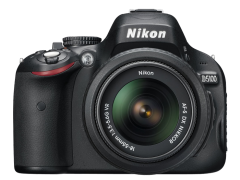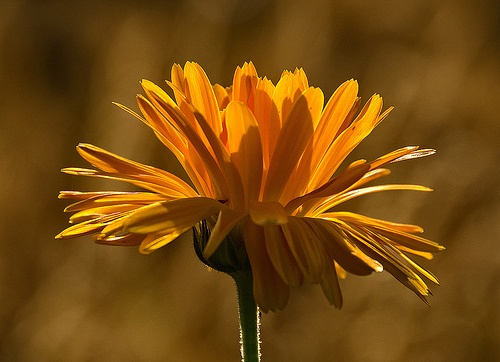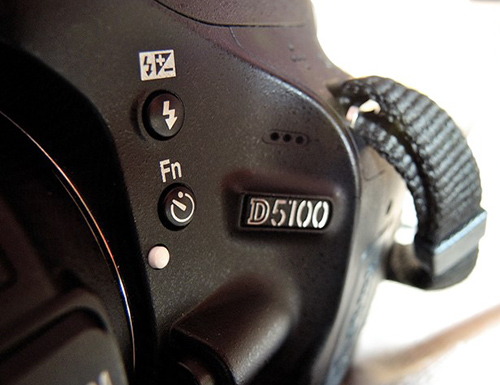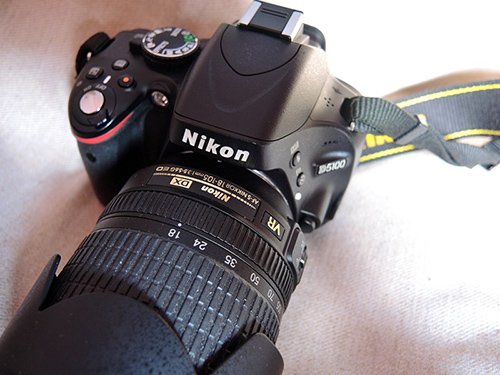 This is Part II of the article titled “Is It Worth Buying Nikon D5100 Now That D5200 Is Here?”. Refer Part I of the article here.
This is Part II of the article titled “Is It Worth Buying Nikon D5100 Now That D5200 Is Here?”. Refer Part I of the article here.
Effects: In line with its pre-determined role (as a so-called ‘entry level’ dslr that also has highly advanced features tucked in the menu) of capturing a high percentage of the dslr buying populace on the planet, the D5100 has a typically point-and-shoot fun feature marked ‘Effects’ on the mode dial. These effects are usable both before as well as after shooting (available in Image Review > Retouch feature in the menu).
I have used some of these, including selective color, color sketch, high and low key, silhouette, even fish-eye and miniature effect (the latter imparts a sort of perspective control focus selectivity to an image), but I rarely use them unless I’m in the mood for experimentation. There is even an HDR (High Dynamic Range) feature in the camera that takes two shots and combines them to produce a JPEG with a wide range of tones. It works quite well, actually.
I also liked combining color sketch effects with further in-camera conversion to monochrome line drawing, though. I used both versions for some post processing of portraits and, in conjunction with a little retouching in Photoshop to remove facial excesses caused by the effect and finally ended up with some interesting results.
The D5100 has a lot of serious features that allow you to take complete charge of the camera, as possible in Full Manual mode, or in partial control, as in the ‘P’, ‘S’ and ‘A’ settings. Not being a purist, I don’t believe in posturing and insisting on shooting on Manual all the time. I aim to take good pictures that suit my taste or reflect my vision and if the D5100’s automatic and semi-automatic modes let me do that, why should I complain?

The D5100 rarely lets me down, because I am beginning to understand how to use the various features. In fact, it occasionally surprises me with its immense possibilities. I don’t think that, even after a year with the camera, I know all its features intimately, such is the depth of the features this camera offers.
Metering & Focus In D5100
Metering and focus are two things that are of immense importance as far as IQ (image quality) goes. Why?
You can choose to leave the camera on ‘Auto Area’ or AF-A mode, in which case the camera decides where you want the focus point to be. A comprehensive in-camera database of 30,000 images shot under a variety of conditions means that the camera’s algorithms possess an almost prescient knowledge of your intentions. I use this setting very often, especially when all else fails, and it has yet to let me down.
AF-C goes one better; it enables continuous focus. So if the subject is moving, the camera will track it automatically across the frame. This is particularly great for movies. And for portraits!
An option worth looking at is the ‘Single Point focus’ setting. The D5100 has 11 focus points, visible as red dots that light up when the shutter button is depressed half way. Of these 11, only the central point is a cross-type sensor, i.e., it is able to read depth as well as lateral placement of an image. No issues; in the field, all the red dots work about equally well. If you are in the mood to be choosy, the four arrows on the multi-controller on the back may be used to select the red dot in case you wish to place it at the focus point of your choice.
A word of caution here: Some people focus and then recompose the view in the viewfinder. They forget that if the plane of focus changes while doing so, the focus will shift to another point of the image and your main area (such as the eye in a portrait) will be slightly out of focus. If I feel the point of focus set by me will shift when I recompose, I prefer to use the nearest red dot to use as the focusing aid. A half press of the shutter button will tell me if it’s where I want the focus point to be. It’s quite simple, really.
I repeat, please be vigilant, there are pitfalls involved in focusing with DSLRs. I’ll repeat the whole thing because it’s so crucial to the quality of your images.
Say you are shooting a portrait; you position the central red dot (the one with the lone cross-type sensor) directly on the subject’s nearest eye and squeeze the shutter release. Will you always get a sharp image? Not necessarily! That’s because the red dot you’re relying on as last positioned by you may be miles off course simply because the plane of focus shifted as you recomposed.
Two more minor niggles in the D5100. It is very easy to accidentally nudge the arrows on the multi-controller while taking the camera out of the bag or carrying case. This has the effect of shifting the focusing point to a sensor other than the one you set last. It’s something worth bearing in mind that there is no way to lock a sensor in place. By the way, I usually keep my 18-105mmG f.3.5~5.6 AF-S zoom-Nikkor more or less permanently mounted on my D5100. More about this lens in a later review.
My advice is to set the camera on AF-C, i.e., continuous autofocus. This ensures that, after I’ve focused, even the slightest subject or camera movement does not cause defocus, since any slight focus shift is immediately rectified by the camera! It took me a long time to figure this one out.
Finally, there are the canned exposure modes, which Nikon refers to as ‘Scene’ mode (on the mode dial). Select the Auto Scene mode and the camera will decide (after consulting the database) the settings appropriate for the scene. It works quite well, too!
There are also a whole lot of other scenes, from pet portrait, food, night portrait, night landscape, beach / snow, and sunsets/sunrises. These are perfect for beginners or those who want to take an ‘insurance’ shot with Scene mode, to cover their earlier attempt(s) with the PASM modes. The D5100 tries very hard to ensure that you get your picture!
Functions And Buttons
The D5100 has a very minimalist design for such a powerful instrument. The hinged (beautiful, 921K dot), articulating display takes up a lot of room, which seems to have given the Nikon designers an excuse to avoid too many function-specific buttons.
In fact, to my dismay, there are no buttons for selecting ISO, WB (white balance) or drive mode/release mode (the D3100 and the D5200 both have a lever/button respectively, to adjust the drive mode in a jiffy). No, the lever below the mode dial – unlike the one on the D3100 – does not have anything to do with drive/release mode; it initiates and cancels live view. Talk about confusing! One is required to dive into the menu for making the drive / release (single, continuous, self timer, quiet) settings.
The lone Fn button, sitting below the flash pop-up button on the left of the camera, enables you to select one out of several functions. Most people prefer to set it to enable selection of the ISO – one presses it while turning the command dial with the thumb till the ISO of choice is reached.
By the way, twirling the command dial while pressing the flash button offers various flash setting options and if the +/- exposure button is also pressed (apart from the flash button) one can even adjust the flash compensation. This really neat feature allows one to adjust the output of not only the built-in flash but even a (compatible) external flash like the Nikon SB 700, mounted on the hot shoe.

The few buttons on the back will be familiar to all users of digital cameras. There are two or three buttons, however, that I’d like to single out for comment.
The first one is the Info button on the top plate. Not to be confused with the i button on the back (which offers a short-cut to the select screen menu, for fast re-setting of options) the rather useless INFO button’s sole purpose is to switch the LCD either on or off. Since the i button also does this on first press (on being pressed a second time, it makes the shooting menu go ‘live’, for editing), this button could well have been assigned to setting the ISO. Pity! Did the Nikon designers run out of coffee just then?
The second button I’ll comment on is not one but two! See the green dots next to the Menu and i buttons? Press and hold these two buttons simultaneously for a couple of seconds and voila! — all the settings you’ve so painfully made, menu after sub-menu, are returned to their factory (default) settings! Only for emergency use, viz., if you’ve really gone and messed up your settings irretrievably/ in-comprehensively. I’d advise you to give this two-button arrangement a wide berth.
The AE/AF Lock button can be configured to lock exposure, focus or both via the menu. I rarely bother with it, being quite used to focusing with a half press of the shutter button and relying on the meter to fine tune the exposure with the +/- exposure compensation button and twirling the command dial with the thumb.
The less said about the multi-control dial at the back the better. I’m referring to the one with the four arrows at the cardinal points of the compass. It’s bad enough that it doesn’t enable access to focus settings, ISO or WB; it’s a plain insult that it doesn’t even have a control wheel for fine tuning various options or scrolling through sub-menus (or scrolling through images by rotating the [non-existent] knurled ring, as found on the Coolpix P510 and P7700).
Apart from the OK button at its center (which is used to confirm/lock in settings made in the menu) the only other useful feature is the four arrows, used for scrolling through menu or sub-menu items, or sifting through images in playback mode (initiated by the button with the “->” next to the rubberized thumb pad).
The magnifying and help/negative magnification buttons and the obvious trashcan button (the second press permanently deletes images in the playback mode) round up our review of the buttons; a drought area in this otherwise wonderful imaging instrument.
The Final Verdict
Light (540 gms with battery and card); APS-C (Nikon calls it DX) sensor 23.6mmx 15.6 mm, 16.2 MP resolution (as against the near identical sized but 24.1 MP sensor of the D5100; pixel size 4.79µ as against the D5200’s 3.92µ pixels; a 921K, brightness adjustable, swivelling LCD; GPS compatible (optional GP-1 unit); inexpensive wireless remote (ML-L3); mono built-in mike, but an optional ME-1 stereo microphone is mountable in the hot shoe, plugging into the relevant port under the flap on the left side of the body; accepts all of Nikon’s fabulous speedlights including the SB 400, SB 600, SB 700, SB 900, SB 910 – all giving multi-flash capability using an optional flash controller and thus able to wirelessly sync into Nikon’s amazing Creative Lighting System (CLS) giving infallible iTTL capability; Nikon’s proprietary Active D-Lighting tone management system; ability to use (one way or the other) almost all Nikkor lenses and an unknown number of lenses from independent manufacturers; standard ¼” screw threaded, steel tripod receptacle on the base; Full 1080 autofocus HDMI video @30 fps, video out to HDTV; EN-EL14 battery (shared with the D3100, P7100 and P7700; not weatherproof but adequately rugged body made of tough polycarbonate composite (also a ‘plastic’, but not exactly the stuff your bathroom mugs are made of !); SD, SDHC, SDXC and Wi-Fi card compatible; alas! only one card compartment; insane 102,000 night vision ISO speed in Effects; many special effects possible in movie mode; two-image HDR jpegs done in-camera; multiple exposures possible; in-camera Nikon Electronic Image (.NEF) – raw image processing… the list goes on and on. Yet, the D5100 could have been even more, at little extra cost.
Such a capable machine, so well balanced, responsive and cooperative once you get the hang of it, such amazing image quality… yet so many opportunities missed, thus falling slightly short of true greatness. But hardly surprising, really; it fits the schizophrenic character of the D5100 — a camera with an induced identity crisis.

It’s incomprehensible, this inscrutable willingness of the Nikon design team to let a potentially great camera like the D5100 fall between two stools, to dumb down a powerful camera and hobble it into submission, to force it to accept its role as a mere upper entry level beast and thereby not pose a challenge to the model above it in the pecking order — the D7000 (with which it shares its famous 16.2 MP sensor and EXPEED C2 processor).
It goes without saying that this undeniably attractive, powerful, sweet handling, fast shooting instrument (once suitably configured) is deprived of its rightful place in the sun, in favor of the D7000 which, by default (as the beneficiary of Nikon’s full and not-so-impartial attention) is the top-of-the-line model. I suspect it’s all done on purpose, to achieve what the marketing boys call product differentiation. But this is going a mite too far…even with all the suggested tweaks, there is enough to differentiate the two. They needn’t have hung, drawn and quartered the D5100.
All said and done, image for image, the D5100 is a camera hard to beat. I do not think ‘moving up’ to the D5200 from the D5100 is a wise move: the D5100 is strong medicine indeed and is likely to remain so far into the foreseeable future. Selling at a price point slightly below the D3200 today, the D5100 is the must bargain of the decade. Snap it up while stocks last.

